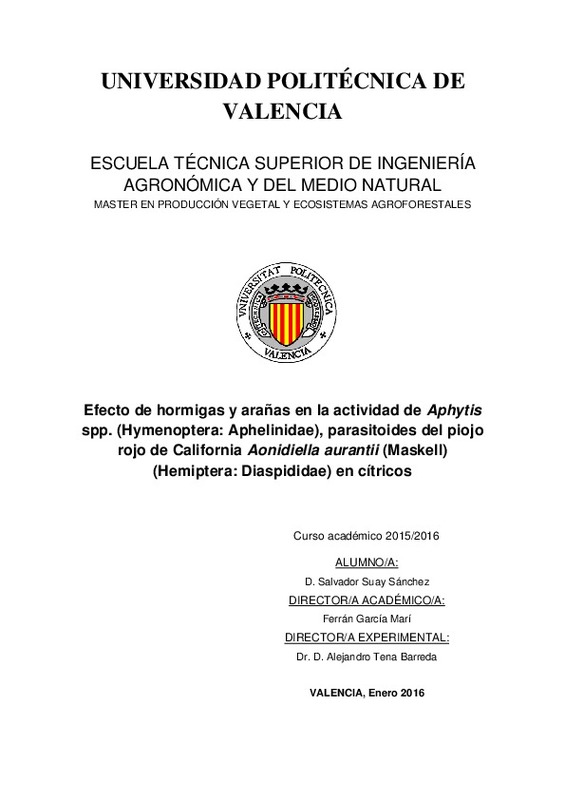|
[EN]
Aonidiella aurantii (Maskell) (Hemiptera: Diaspididae) is one of the most important citrus pest in the Mediterranean area. Parasitoids of genus Aphytis (Hymenoptera: Aphelinidae) are its main natural enemies and ...[+]
[EN]
Aonidiella aurantii (Maskell) (Hemiptera: Diaspididae) is one of the most important citrus pest in the Mediterranean area. Parasitoids of genus Aphytis (Hymenoptera: Aphelinidae) are its main natural enemies and control this pest in several citrus areas but not in Spain. In order to improve the biological control of A. aurantii, the effect that ants and spiders may have on these parasitoids (population levels, parasitism and emigration) has been studied in an exclusion assay in a citrus orchard. Ants and spiders have been documented as predators of Aphytis in the literature. Two species of ants Lasius grandis Forel and Pheidole palidulla (Nylander) (Hymenoptera: Formicidae) and 19 species of spiders were identified as potential predators of Aphytis and excluded from half the sampled trees. The most abundant species of spiders were Cheiracanthium mildei (Koch) (Araneae: clubionidae), Icius hamatus (Koch) (Araneae: Salticidae), Ballus chalybeus (Simon) (Araneae: Salticidae) y Philodromus rufus (Walck) (Araneae: Phylodromidae). Although Aphytis populations tended to increase in exclusion trees there were not significant differences with control trees. This increase could be explained by the lower emigration rates, although neither significant, of Aphytis melinus DeBach (Hymenoptera: Aphelinidae) males in exclusion trees. Parasitism rates were similar in both treatments. Therefore, any of these two groups of predators affected negatively the activity of Aphytis parasitoids at least at the short period of this study.
[-]
[ES]
Aonidiella aurantii (Maskell) (Hemiptera: Diaspididae) es una de las plagas más importante de los cítricos del área Mediterránea. Los parasitoides del género Aphytis (Hymenoptera: Aphelinidae) son sus principales ...[+]
[ES]
Aonidiella aurantii (Maskell) (Hemiptera: Diaspididae) es una de las plagas más importante de los cítricos del área Mediterránea. Los parasitoides del género Aphytis (Hymenoptera: Aphelinidae) son sus principales parasitoides y controlan a esta plaga en diversos países citrícolas pero no en España. Con el fin de mejorar el control biológico de A. aurantii se ha estudiado el efecto que hormigas y arañas pueden tener sobre estos parasitoides (nivel poblacional, parasitismo y emigración) mediante ensayos de exclusión a corto plazo en una parcela experimental de cítricos. Estos dos grupos de enemigos naturales se han citado como depredadores de adultos de parasitoides del género Aphytis. En el presente estudio se identificaron y excluyeron dos especies de hormigas y al menos 19 especies de arañas. Las especies más abundantes de depredadores potenciales fueron las hormigas Lasius grandis Forel y Pheidole palidulla (Nylander) (Hymenoptera: Formicidae) y las arañas Cheiracanthium mildei (Koch) (Araneae: clubionidae), Icius hamatus (Koch) (Araneae: Salticidae), Ballus chalybeus (Simon) (Araneae: Salticidae) y Philodromus rufus (Walck) (Araneae: Phylodromidae). Aunque las poblaciones de Aphytis tendieron a aumentar en los árboles donde se realizó la exclusión estas diferencias no fueron significativas. Este ligero aumento pudo deberse en parte a la tendencia a no emigrar de los machos de Aphytis melinus DeBach (Hymenoptera: Aphelinidae) en los árboles donde se realizó la exclusión. Ninguno de los parámetros que se utilizaron para medir la actividad parasitaria de los Aphytis mostró que la exclusión de los depredadores potenciales fuera beneficiosa para estos parasitoides. Por lo tanto, se puede concluir que ninguno de estos dos grupos de depredadores tiene un efecto negativo a corto plazo sobre Aphytis.
[-]
|







